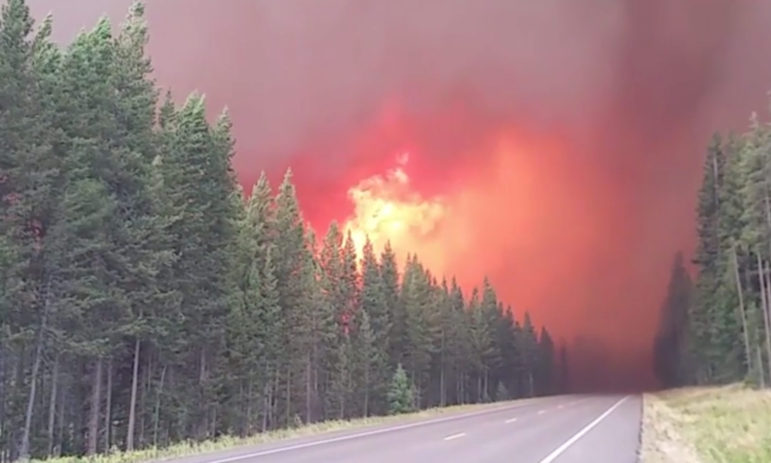
A frame from a video shot Wednesday shows the Berry Fire in Grand Teton National Park burning in heavy timber close to U.S. Highway 89. Officials have closed the road, which connects Grand Teton and Yellowstone National Park, resulting in the closure of Yellowstone’s south entrance, as well as some trails, a campground and a lodge in Grand Teton. The closures may last several days, depending on fire activity, weather and other factors.
UPDATE: As of Tuesday, Aug. 30, the south entrance to Yellowstone National Park has reopened, and all roads in the park are open.
Authorities have closed the main connector road between the south end of Yellowstone National Park and northern border of Grand Teton National Park after a wildfire that started last month has grown to nearly 7,000 acres.
The closure means vacation travelers must detour at least 150 miles to move between the neighboring parks, which are connected by an 8-mile scenic parkway.
Officials in Grand Teton closed U.S. Highway 89 near the north end of Jackson Lake because of active burning in trees along the roadside and heavy smoke from the Berry Fire, sparked by lightning on July 25.
The fire has prompted the closure of the South Gate to Yellowstone, which last month saw an average of more than 2,400 vehicles each day carrying visitors between the two parks. Four other entrances into the park remain open.
Three Grand Teton trails, a campground and a lodging complex near the fire have also been closed, a move that could last several days, depending on fire activity, weather and other factors.
Traffic is being re-routed to West Yellowstone, where crews are working to contain the Maple Fire, which has burned more than 27,000 acres and moved to within four miles of the town of West Yellowstone, Mont. It has also burned close to the Madison River along the park’s West Entrance Road.
The West Gate remains open, and firefighters say they are confident they can prevent the Maple Fire from reaching the road between West Yellowstone, the park’s busiest entrance, and Old Faithful, the most popular attraction in Yellowstone. Despite the complications, traffic entering the West Gate was moving smoothly and without delay Wednesday afternoon.
The Maple Fire, along with two other fires burning in more remote areas of Yellowstone, were all caused by lightning, and are burning in timber and undergrowth left primed by a dry spring and summer. Many fires in Yellowstone are allowed to largely follow their natural course, as long as they don’t threaten buildings, roads or developed areas.
Wide swaths of the park burned by previous fires, including the historic 1988 blazes that scorched nearly a third of Yellowstone, serve as a natural check on the movement of new wildfires.
The blazes come at the height of the summer tourist season, and as officials in both parks prepare for celebrations set for Thursday marking the 100th anniversary of the creation of the National Park Service.
Interior Secretary Sally Jewel and National Park Service Director Jonathan Jarvis are both scheduled to speak tomorrow at an event in Gardiner, Mont. at Yellowstone’s North Gate.
